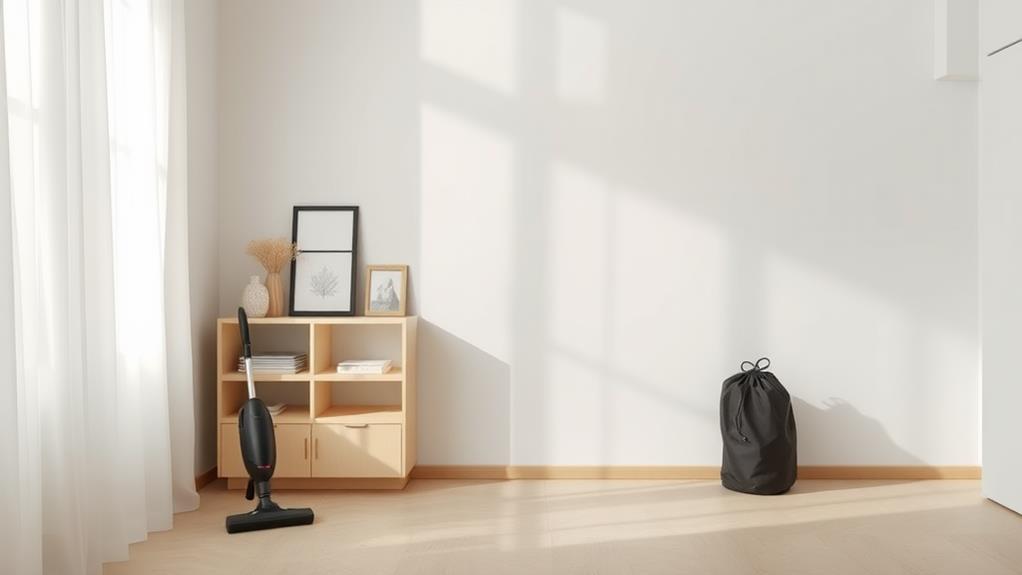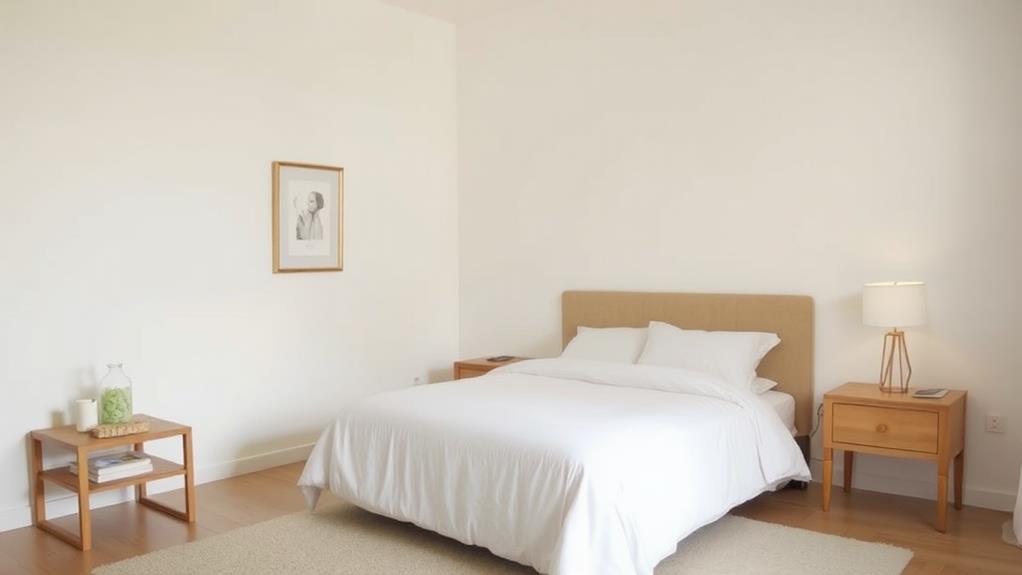To declutter any room in just 15 minutes, start by choosing a specific area, like a drawer or countertop. Gather your supplies: trash bags, a timer, and organizing bins. Set a timer for 15 minutes to keep you focused. Quickly sort items into three categories: keep, donate, or toss. For items you're unsure about, use a temporary box. Organize the essentials neatly and create designated spots for frequently used items. Finally, keep a donation box nearby for easy access. By following this method, you can maintain an organized space effortlessly and discover more strategies to streamline your home.
Summary
- Choose a specific focus area to tackle and prioritize overwhelming spaces for quick results.
- Set a timer for 15 minutes to create urgency and maintain focus on decluttering.
- Sort items into categories: keep, donate, and toss, making quick decisions to maintain momentum.
- Organize items neatly by grouping similar items and designating specific spots for easy access.
- Maintain a donation box and regularly assess items for decluttering to sustain an organized environment.
Assess the Cluttered Space

Clutter can create chaos in your living space, making it hard to focus and relax. To tackle it effectively, start by evaluating the cluttered space.
Look around and identify clutter triggers—those areas where items tend to accumulate. Is it your desk, a corner of the living room, or the kitchen counter?
Once you pinpoint these spots, evaluate any emotional attachments you have to the items there. Are you holding onto things out of guilt or nostalgia? Understanding these attachments helps you decide what to keep and what to let go.
Take a systematic approach: categorize items and set criteria for what stays. By recognizing triggers and attachments, you'll set the stage for a more streamlined, innovative living environment.
Set a Timer

Setting a timer is essential for staying focused and motivated while you declutter.
Choose a specific area to tackle and give yourself a strict time limit, like 15 minutes. This approach keeps you on track and helps prevent overwhelm.
Importance of Time Limits
Using a timer can transform your decluttering efforts from overwhelming to manageable. By setting time limits, you create a sense of urgency that boosts your focus and productivity. This time management technique helps you tackle clutter systematically, ensuring you don't get sidetracked by distractions.
When the timer starts, you'll feel motivated to make quick decisions about what to keep, donate, or discard. Additionally, these productivity tips keep the process enjoyable; you can see tangible results in just 15 minutes.
You'll develop a habit of decluttering regularly, preventing future overwhelm. Embrace the power of time limits, and watch how it revolutionizes your approach to organizing any room. Start now, and reclaim your space efficiently!
Choose a Focus Area
Choosing a focus area is essential for effective decluttering. Start by identifying a specific space that needs attention, like a drawer or a corner of a room. This focus area benefits your decluttering process by allowing you to concentrate your efforts and see immediate results.
Set a timer for 15 minutes to keep you on track. This creates urgency and helps you prioritize spaces that feel overwhelming. As you work, tackle items systematically—decide what to keep, donate, or discard.
Gather Your Supplies

Before you start decluttering, gather your supplies to streamline the process.
You'll need essential tools, like trash bags and cleaning cloths, along with organizing containers and bins to sort items effectively.
Don't forget a timer to keep your sessions focused and efficient.
Essential Decluttering Tools
To kick off your decluttering session, gather a few essential tools that'll make the process smoother and more efficient.
Start with a sturdy trash bag for items to discard; this aligns with your minimalist mindset. Next, grab a box or bin for items you're unsure about—these can serve as temporary holding spaces.
A notepad and pen will help you jot down decluttering strategies or notes for future organization. Finally, have a timer ready to keep your session focused and on track.
With these tools, you'll streamline your efforts and tackle clutter with confidence. Remember, the goal is to create a space that reflects a clutter-free, innovative lifestyle that fosters clarity and creativity.
Organizing Containers and Bins
Once you've gathered your decluttering tools, it's time to focus on organizing containers and bins.
Choose innovative storage solutions that suit your space and style. Look for bins that are stackable, clear, or labeled for easy identification. Consider using baskets for soft items and drawer organizers for smaller gadgets.
When selecting containers, think about the items you need to store and their frequency of use. Keep frequently used items within easy reach, while less-used items can go into deeper storage.
Utilize vertical space by stacking bins or using shelving units. Remember, effective bin organization not only maximizes space but also streamlines your daily routine.
With the right containers, decluttering becomes a breeze!
Timer for Focused Sessions
Setting a timer can transform your decluttering process into a focused, efficient session. Start by gathering your supplies: a timer, trash bags, and donation boxes.
Choose a timer technique that suits you, like the Pomodoro method, where you work for 25 minutes followed by a 5-minute break. This approach enhances focused productivity, keeping you engaged without burnout.
Once you've set the timer, immerse yourself in one specific area, like a drawer or shelf. Stay committed to the time limit, and resist distractions.
When the timer goes off, evaluate your progress. Celebrate small victories and reset the timer for another focused session.
Focus on One Area
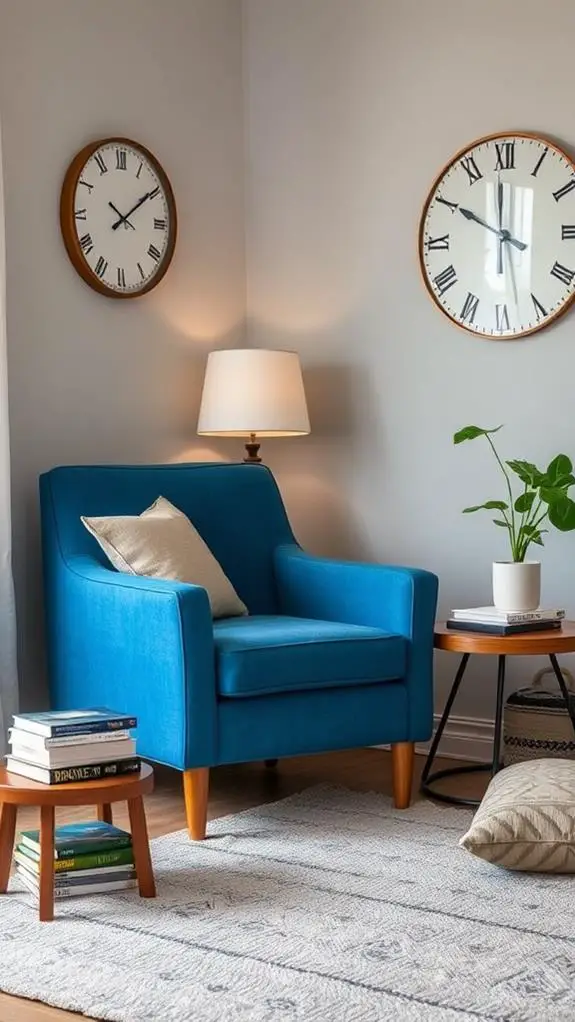
How do you eat an elephant? One bite at a time.
In decluttering, focus on one area, like a shelf or a corner. This concentrated approach keeps the task manageable and less overwhelming.
Use visual decluttering techniques to identify what stands out—remove anything that doesn't align with your vision.
As you sort, prioritize sentimental items; these hold value and shouldn't be rushed through.
Create a system: set aside items you want to keep, donate, or discard.
By honing in on a specific space, you'll see progress quickly, motivating you to tackle the next area.
Sort Items Quickly

Sorting items quickly is essential for maintaining momentum during your decluttering session. Start by designating specific categories—like keep, donate, and toss. Use boxes or bags to make the process straightforward.
As you go through each item, practice quick sorting: if it doesn't spark joy or serve a purpose, place it in the 'donate' or 'toss' pile. Focus on efficient categorization; group similar items together to visualize what you have and what you truly need.
Set a timer for 15 minutes, and challenge yourself to sort through a defined space. This urgency boosts your productivity and keeps you engaged. Remember, the goal is to streamline your space, not get bogged down by indecision.
Decide What's Essential

Determining what's essential in your space is crucial for effective decluttering. Start by identifying your must-have items—those daily necessities that align with your lifestyle.
Next, evaluate each item's practical usage. Does it serve a purpose, or is it merely taking up space? Consider your personal priorities: what truly matters to you?
If something holds sentimental value, ask if it enhances your life or creates emotional attachment that hinders your progress. Adopting a minimalism approach helps streamline your belongings, ensuring everything you keep reflects your values.
Create a "Throw Away" Pile
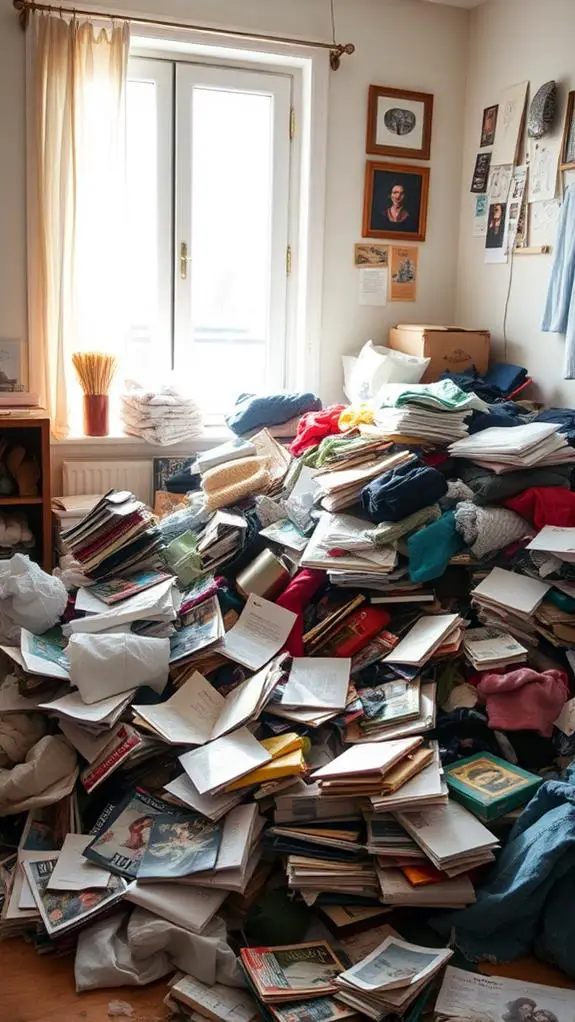
Once you've identified what's truly important in your space, it's time to tackle the clutter.
Start by creating a "throw away" pile. Use effective throw away strategies, like setting a timer for five minutes and quickly evaluating items. If you haven't used it in the past year or it doesn't spark joy, toss it in the pile.
This approach not only helps you clear physical space but also aligns with the benefits of minimalism, fostering mental clarity. As you work through your belongings, remember that every item you throw away is a step towards a more intentional living environment.
Embrace this process; you'll feel lighter and more organized in no time. Ready, set, declutter!
Organize Items Neatly

To create a sense of order in your space, focus on organizing items neatly. Start by grouping similar items together, which promotes a minimalist mindset. Instead of haphazardly placing things, designate specific spots for each category.
For instance, keep books on shelves, kitchen utensils in drawers, and office supplies in a single container. Use labels to help you remember where everything belongs—this aids in clutter free living.
Ensure that every item is visible and easily accessible; if you can't see it, you're likely to forget it. Prioritize functionality and aesthetics, creating a streamlined look.
Utilize Storage Solutions
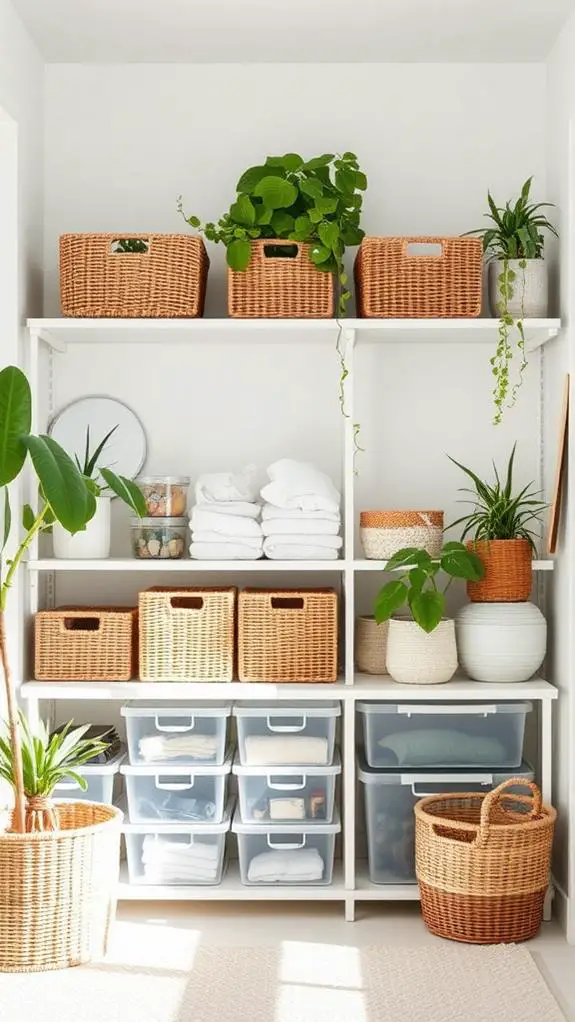
Organizing your items neatly sets the stage for effective storage solutions.
Focus on creative storage that maximizes your space. Use multifunctional furniture like ottomans with hidden compartments to keep items out of sight.
Don't overlook vertical space; install shelves to store books or decorative boxes, keeping your surfaces clear.
Identify underutilized areas, such as the space under your bed, for seasonal storage.
Employ labeled containers for easy access and organization.
Adopting a minimalist approach can simplify your life, reducing clutter and making room for what matters.
Implement space-saving hacks, like stacking bins or using wall-mounted racks, to guarantee every item has its place.
With these strategies, you'll transform chaos into order in just minutes.
Maintain a Donation Box
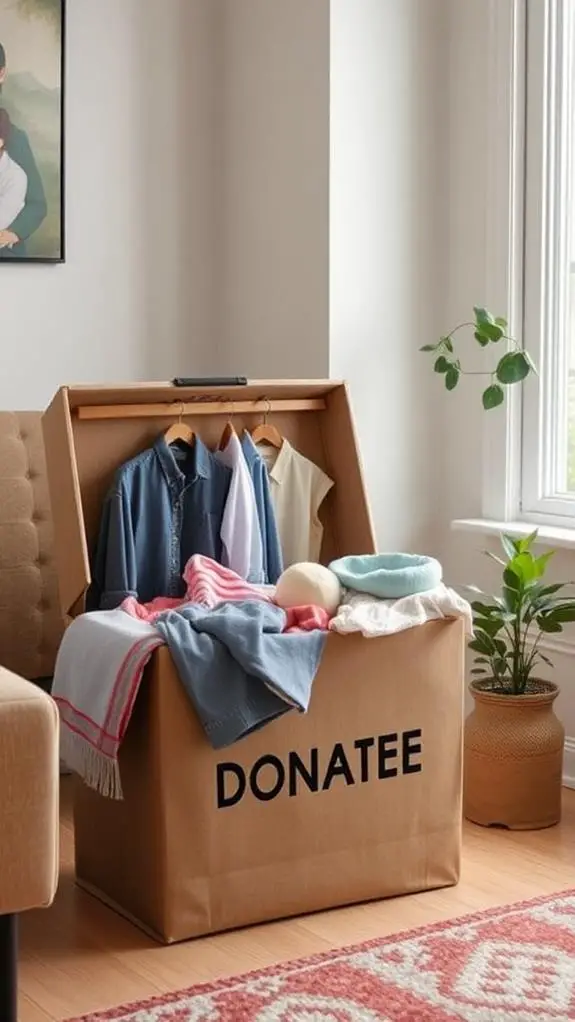
Keeping a donation box handy can make decluttering feel less intimidating. Designate a specific spot in your home for this box, and commit to using it regularly.
As you sort through items, ask yourself if they meet the donation guidelines—are they in good condition and still usable? If so, toss them in the box.
Regularly check local community resources for donation opportunities. Many organizations will gladly accept your gently used items, sometimes even offering pick-up services.
Set a reminder to empty the box every month, ensuring it doesn't overflow and that you're consistently contributing to your community.
Clean Surfaces After Decluttering
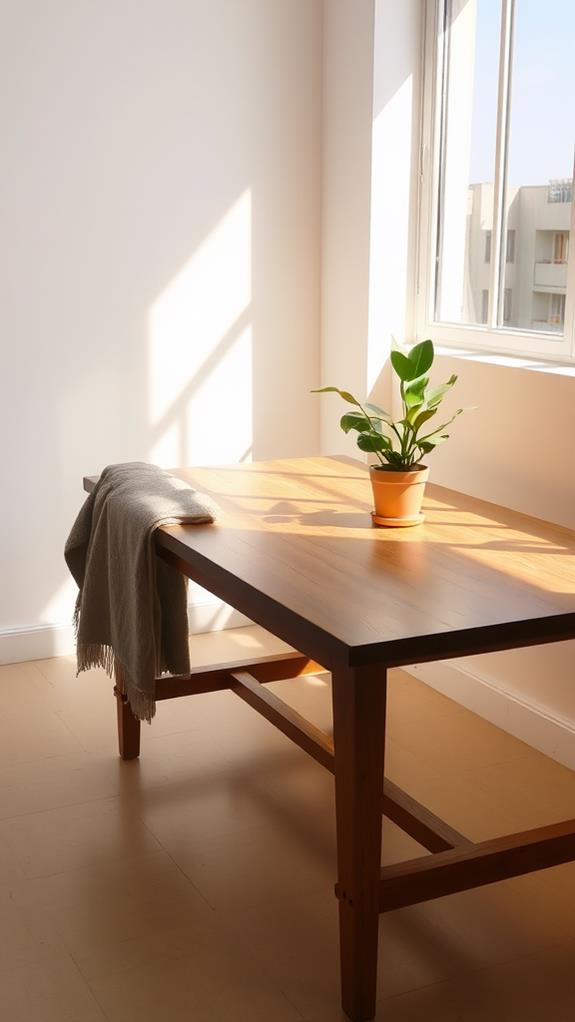
A clean surface can transform the overall feel of a room, making it more inviting and less chaotic.
After decluttering, it's crucial to apply effective cleaning techniques tailored to different surface materials. Start with a microfiber cloth for dusting wood and metal surfaces, ensuring you catch every particle.
For glass, use a streak-free cleaner, wiping in a circular motion. If you're dealing with fabrics, vacuum thoroughly or use a lint roller for quick results.
Don't forget to sanitize high-touch areas like tables and countertops with disinfectant wipes.
By focusing on these cleaning techniques, you enhance the room's aesthetic and create a fresh, organized environment.
With surfaces clean, you'll feel more relaxed and ready to enjoy your space.
Establish a Routine

Creating a decluttering routine can simplify your efforts and maintain an organized space. Start by setting aside just 15 minutes daily for decluttering tasks. Use this time to focus on specific areas—like a drawer, shelf, or countertop. Establishing these decluttering habits will help you chip away at clutter without overwhelming yourself.
Integrate decluttering into your daily routines. For instance, while waiting for your coffee to brew, sort through a few items. Consistency is key; make it a habit to assess and organize as you go.
Over time, these small efforts will accumulate, leading to a more organized environment. Remember, it's about progress, not perfection. Stick to your routine, and soon, decluttering will feel second nature.
FAQs
What if I Feel Overwhelmed During the Decluttering Process?
When you feel overwhelmed during decluttering, it's crucial to focus on quick wins.
Break the task into smaller sections, tackling one area at a time. This approach helps in overcoming anxiety, as you'll see immediate progress.
Set a timer for a few minutes and commit to that short burst of effort. Celebrate each small victory—it builds momentum and keeps you motivated.
How Can I Stay Motivated to Declutter Regularly?
To stay motivated for regular decluttering, set clear decluttering goals. Break them into smaller tasks to make them manageable.
Implement a reward system: after completing a task, treat yourself to something small, like a favorite snack or a quick break. This creates positive reinforcement, making the process enjoyable.
Regularly revisiting your goals and rewards keeps the enthusiasm alive, transforming decluttering from a chore into a fulfilling routine that you look forward to.
Can I Declutter With Kids or Pets Around?
Yes, you can definitely declutter with kids and pets around!
Use kid-friendly strategies like involving them in the process; let them sort toys or choose items to donate.
For pet-proof decluttering, guarantee fragile items are out of reach and create a designated area for your pets to relax.
Set a timer for quick sessions, making the process fun and engaging, while keeping distractions to a minimum.
You'll achieve a tidy space without the chaos!
What Should I Do With Sentimental Items?
When dealing with sentimental items, start by evaluating each piece. Identify memorable keepsakes that truly resonate with you and set them aside.
For items with emotional attachments, consider taking a photo instead, allowing you to preserve the memory without keeping the physical item.
If you find it difficult to part with certain pieces, limit yourself to a designated box. This systematic approach helps maintain your space while honoring your cherished memories.
How Often Should I Declutter Each Room?
You should create a decluttering schedule based on your room priorities.
Start by evaluating which rooms need attention most; bedrooms and kitchens often require more frequent checks.
Aim for a quick declutter every month in high-traffic areas and quarterly for less-used spaces.
By staying consistent, you'll prevent clutter from piling up.
Conclusion
In just 15 minutes, you can transform any cluttered room into a more organized space. By evaluating the area, setting a timer, and focusing on one section at a time, you'll make quick progress. Remember to sort items efficiently and utilize storage solutions to keep things tidy. Don't forget to maintain your donation box for items you no longer need. Establishing a routine will help you stay organized and make decluttering a breeze in the future.

